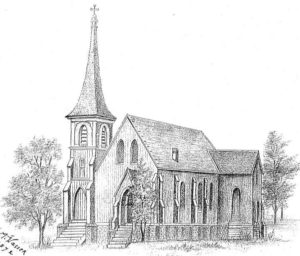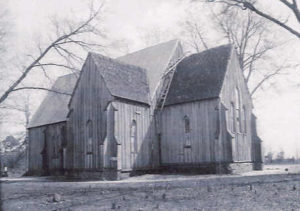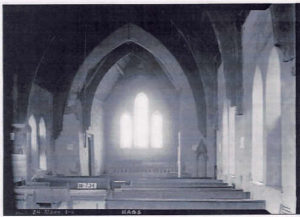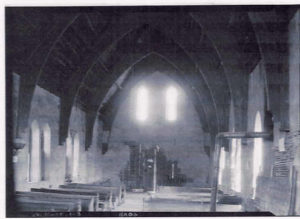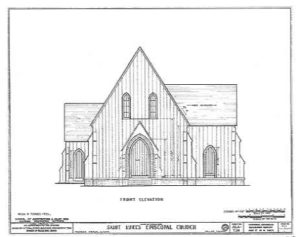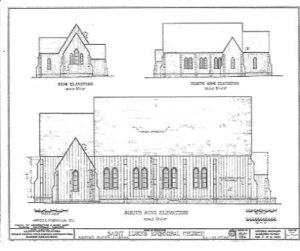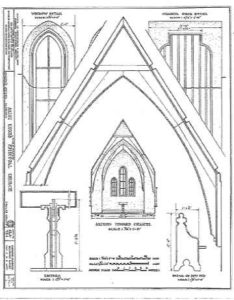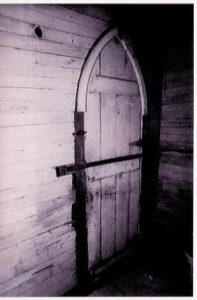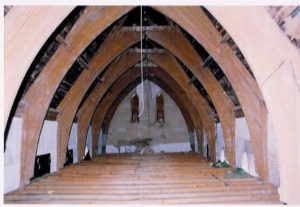St. Lukes Church
St. Luke’s Cahawba 1854 – 1876
The preservation and restoration of St. Luke’s Episcopal Church, Cahawba, Alabama is of critical concern to the Cahawba Advisory Committee (CAC) and all friends of Cahawba. This structure captures an essence of Cahawba and the history that the Cahawba Advisory Committee seeks to preserve. Please take a few minutes to explore this history of St. Luke’s and how you can help preserve this historic treasure.
Time Line
Compiled April 2004 by James Hammonds, Cahawba Advisory Committee In the Fall of 2006 the Cahawha Advisory Committee, the Alabama Historical Commission and the Auburn University College of Architecture’s Rural Studio formed apartnership to save St. Luke’s Church. It is currently being disassembled and will be reassembled at Old Cahawba in 2007. |
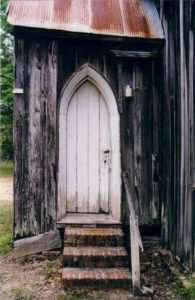 It is necessary to place the St. Luke’s Church Project in proper perspective. The information in this Overview covers 1854 to the present concentrating on developments that effect St. Luke’s Church.
It is necessary to place the St. Luke’s Church Project in proper perspective. The information in this Overview covers 1854 to the present concentrating on developments that effect St. Luke’s Church.
By the early 1900’s Alabama citizens were rediscovering the ghost town that had once been the Capital of Alabama. Located on a peninsula created by the confluence of the Cahawba and Alabama Rivers, its moss covered trees, Indian artifacts, street grid, flora, artesian wells, imposing brick structures, and ruins created an aura hard to resist.
Interest Renewed
In 1908 Anna Gayle Fry’s Memories of Old Cahawba sparked renewed interest. Cahawba became an important excursion site for Archaeological and Historical Societies. In 1925 several hundred people made the pilgrimage to Cahawba to commemorate the 100th Anniversary of LaFayette’s visit. In 1926 annual spring pilgrimages by riverboat were sponsored by the Cahawba Memorial Association. This was a movement to preserve the cemeteries, ruins and structures still standing in Cahawba. Many citizens have spent a lifetime dedicated to this movement.
Organizations Formed
By 1943 the State had created the Cahaba Historical Commission. The Cahaba Historical Commission by enlisting the help of local citizens and the Dallas County Commission managed several projects and reopened the main streets of Cahawba but it did not have condemnation authority or regular State funding and each year more and more structures fell to the elements and vandals. By 1970s only three historic structures were still intact on site. In 1975 authority over the site was transferred to the Alabama Historical Commission (AHC) with the hope of finally developing a State Park at Old Cahawba. The Cahaba Historical Commission became the Cahawba Advisory Committee (CAC); a State Agency tasked with advising the Alabama Historical Commission on the development of Old Cahawba.
Major Progress Made
Some progress was made but it was the 1980s before there was real progress. The advent of the friends group, the Cahawba Concern, and the Cahawba Festival combined with the work of the CAC and local legislators to help the AHC to buy more land, build a welcome center, and hire a full-time staff. By the late 1990s with both the AHC and the CAC receiving regular State funding, hundreds of acres for the Old Cahawba Archaeological Park had been bought. In May of 2000 the AHC voted to acquire the remaining property by whatever means necessary. Since that date the CAC has provided grants to the AHC for that purpose totaling over one million dollars. The remaining property would have been acquired in the next two – three year period but budget cuts will postpone the final phase of land acquisition.
Restoration Begins
The AHC has acquired title to the only two remaining intact historical structures on site, the Fambro House, a 1840s raised cottage, and the Barker Quarters, a two story brick slave quarters. Although money is technically available to stabilize and partially restore the Fambro House and the Barker Slave Quarters, red tape and the lack of a AHC Master Plan combined with current funding issues has prevented much stabilization or restoration.
Perhaps another dozen intact structures that once stood at Cahawba are located in Dallas County. These were moved mostly during the 1870s. The AHC now holds title to the most architecturally significant of these, St. Luke’s Church. The CAC has awarded a $200,000 grant to the AHC to relocate St. Luke’s to Old Cahawba, its stabilization, and the seed money for restoration.
Rear & Side Elevations of St. Luke’s, Martin’s Station, Alabama
Detail Elevations of St. Luke’s, Martin’s Station, Alabama
Special Thanks
The Cahawba Advisory Committee would like to thank Alabama Historical Commission archaeologist Linda Derry for her input and discovery efforts in this critical phase of this project.
http://www.ruralstudio.org/projects/st-lukes-church
